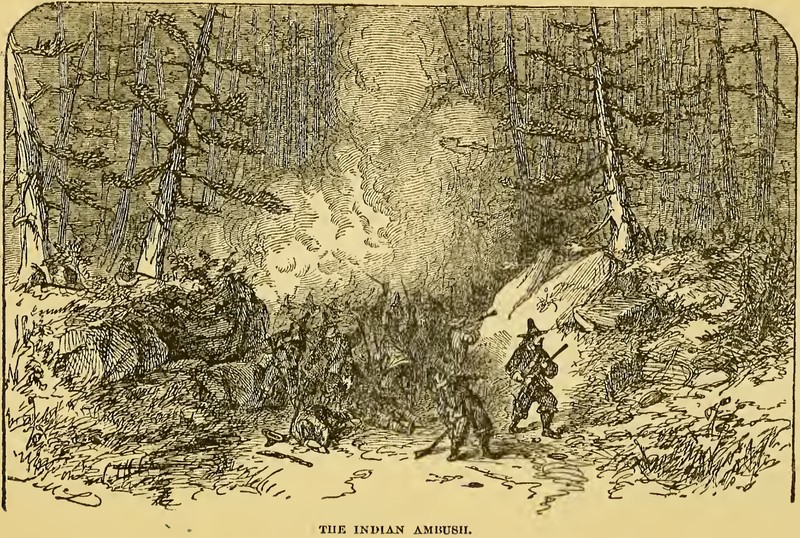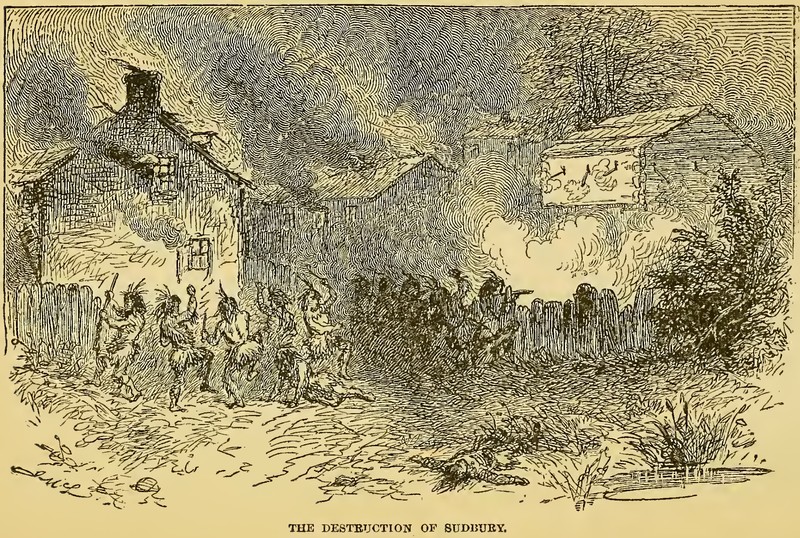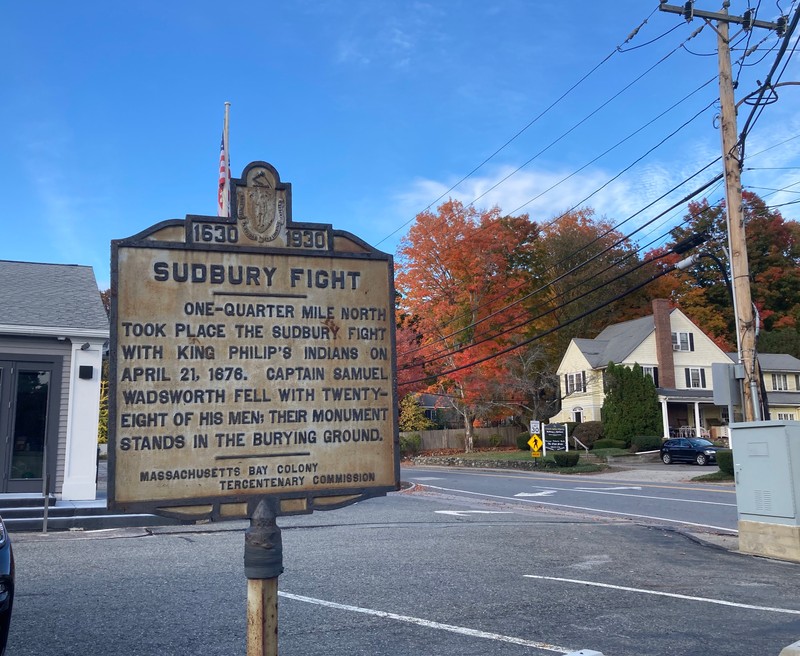Green Hill, Site of the Sudbury Fight of King Philip's War
Introduction
Text-to-speech Audio
In April of 1676, a company of Nipmucs gathered together at Mount Wachusett, about thirty miles west of Sudbury. According to Mary Rowlandson, an Englishwoman who had been taken captive that February, they surrounded a man with two guns in his hands, singing and calling him in and out of the circle until “he stood reeling and wavering as if he knew not whither he should stand or fall, or which way to go.” Another man knelt in the circle’s center upon a deer skin; as he spoke, the group responded in assent throughout. They all rejoiced when the armed man returned to the circle for the final time, and rejoiced again when the kneeling man next to him concluded his speech. “And so they ended their business,” Rowlandson recounted, “and forthwith went to Sudbury fight,” which took place here at Green Hill.
Images
1900 depiction of the Sudbury Fight. Fire in the valley draws English out in the open, where Nipmuc warriors aim their guns in waiting.

1900 depiction of the burning of Sudbury settlement. Nipmuc warriors celebrate as English gunmen try to defend from inside.

Green Hill and Goodman’s Hill lie behind this sign (located at the intersection of Boston Post Road (U.S. 20) and Concord Road), towards the direction of the camera.

Backstory and Context
Text-to-speech Audio
Led by the sachem Muttawmp, about five hundred warriors, mostly Nipmuc (and possibly including Metacom, also known as King Philip), left their camp at Mount Wachusett on the evening of April 20 and stole into Sudbury village on the eastern side of the Sudbury River. There they “lay near [the] Passage” of Captain Samuel Wadsworth of Milton, keeping “themselves undiscovered and permit[ing] him to passe them in the night” as Wadsworth marched his seventy men through town en route to nearby Marlborough. Just as the sun began to slip over the horizon, the Nipmuc set fire to Sudbury. Upon hearing the news Wadsworth immediately turned his troops around to return to Sudbury, but he made the fatal mistake of entering the valley between Green Hill and Goodman’s Hill.
This time the Nipmuc did not let Wadsworth pass by unscathed; they ambushed the English troops from the high ground. Wadsworth’s company, joined by Captain Brocklebank and a few garrison soldiers from Marlborough (about eighty English in all), held out for four hours in a square formation, making their way slowly up Green Hill and losing only five men in the process. Once they had made it to the top, in what they thought was a safer position, the Nipmuc set the dry brush of Green Hill aflame. About thirty men, including Wadsworth and Brocklebank, died trying to escape the choking smoke and the forest that was “alive with warriors.” Early the next morning, Nipmuc victors made a show of shouting seventy-four times near the Marlborough garrison, one for each Englishman “they believed were lying dead in Sudbury.”
One letter printed in London described a Nipmuc warrior taunting an Englishman before killing him, saying “Come Lord Jesus, save this poor Englishman if thou canst, whom I am now about to Kill.” The Nipmuc’s taunt reflected the religious complexities of King Philip’s War: just a few days before, Boston had observed “a day of humiliation,” while the Nipmuc too had sought sacred assistance for victory before the battle. The English chronicler concluded, “We hope the Lord is Arisen to Avenge those blasphemies.”
Almost eight years earlier, in May of 1668, some Nipmuc leaders of nearby “praying towns,” specifically “adjoining Mendon and Marlboroug,” had formed a covenant with the Massachusetts Colony of “humble submission & subjection” in exchange for “protection of the English.” Job Kattenanit, a teacher at Magunkoag and Okkanamesit, was the only actual signer of the document, which declared, “We… being convinced of our great sinns & how good it is to turn unto the Lord and be his servants… give up ourselves to God.” Missionary Daniel Gookin portrayed these “praying Indians” as “desirous and willing to engage against the enemy,” but scholar Lisa Brooks contends that many served under duress only after “months of exposure and starvation,” aiding the English solely for the prospect of provision for their families and to acquire guns.
In the wake of the burning of Sudbury, the Massachusetts Council was “moved to settle some of oʳ faithful Indians” in nearby villages and woods to scout and “prevent the enemies coming in upon yoʳ Colony and ours that way, or at least to give speedy notice of their motions and dissapoynt their mischievous designes.” These included Kattenanit, who arrived with his company in Sudbury the morning after the Fight. They found no one amidst the smoke save four Indian dead and numerous English bodies, which they helped to bury. The “faithful” Nipmuc, at once Christian protectors and, as Gookin described, “painted… like the enemy,” guarded English settlers in mourning.
Nevertheless, not all colonists found this comforting. In spring 1677, Sudbury minister Edmund Browne wrote of Native Americans as “not only Cut purses, but cut throats.” He recommended a policy of intolerance in which all Indians would be sequestered in a designated area under English guard. Their ammunition would be confiscated, their freedoms eroded. Some inhabitants of Marlborough and Sudbury petitioned the General Court for tracts of land known as Whipsuffrage and Ocogooganset, because, they said, “many of which Indians in our late war have proved very perfidious and combine with the common enemy.” They also wished to replace Native occupants with new “habitations” after their old ones had been “burnt.”
Although the fiery Sudbury Fight was a decisive victory for Nipmuc forces, Mary Rowlandson’s description upon their return was one of lament. Rather than “rejoycing and triumphing,” Rowlandson remarked, they “came home… rather like dogs (as they say) which have lost their ears.” They had killed dozens of English including two captains and only lost five or six men, yet during their ceremony afterwards painted their faces black in mourning. Nineteenth century historian Alfred Sereno Hudson asserted that Sudbury was the furthest eastward Metacom won before retreating back west, marking the end of a unified front against English settlement.
Sources
Bodge, George Madison. Soldiers in King Philip's War: Being a Critical Account of That War, with a Concise History of the Indian Wars of New England from 1620-1677. Boston, MA: Rockwell and Churchill Press, 1896.
Brooks, Lisa. “Covenant between Massachusetts Colony & the Nipmuc ‘Praying Towns,’ 1668.” Our Beloved Kin: Remapping A New History of King Philip's War, June 5, 2019. https://ourbelovedkin.com/awikhigan/1668-covenant.
Brooks, Lisa. Our Beloved Kin: A New History of King Philip's War. New Haven, CT: Yale University Press, 2018.
Hudson, Alfred Sereno. The History of Sudbury, Massachusetts: 1638-1889. Boston, MA: R.H. Blodgett, 1889.
Lepore, Jill. The Name of War: King Philip's War and the Origins of American Identity. New York, NY: Alfred A. Knopf, 1998.
Mandell, Daniel R. King Philip's War: Colonial Expansion, Native Resistance, and the End of Indian Sovereignty. Baltimore, MD: Johns Hopkins University Press, 2010.
Rowlandson, Mary. The Captive. Edited by Mark A Ludwig. Tucson, AZ: American Eagle Publications, 1988.
Pulsipher, Jenny Hale. “‘Our Sages Are Sageles’: A Letter on Massachusetts Indian Policy after King Philip’s War.” The William and Mary Quarterly 58, no. 2 (2001): 431–48.
Schultz, Eric B, and Michael J Tougias. King Philip's War: The History and Legacy of America's Forgotten Conflict. Woodstock, VT: Countryman Press, 1999.
https://en.wikipedia.org/wiki/Sudbury_Fight
https://en.wikipedia.org/wiki/Sudbury_Fight
Lena Leavitt
